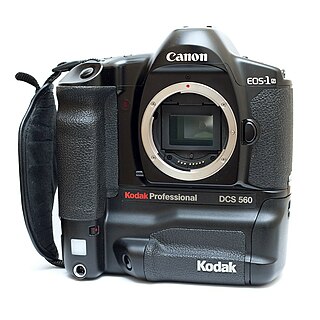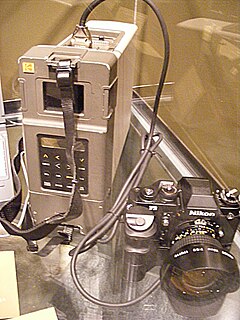| Overview | |
|---|---|
| Type | Single-lens reflex with Digital back |
| Lens | |
| Lens | Interchangeable (EF) |
| Sensor/Medium | |
| Sensor | CCD, 1.3x crop factor (APS-H) |
| Maximum resolution | 3,060 x 2,036 (6.0 megapixels) |
| ASA/ISO range | 80 |
| Storage | PCMCIA card slot |
| Focusing | |
| Focus modes | One-shot, AI-Servo, AI-Focus, Manual |
| Focus areas | 5 points |
| Focus bracketing | none |
| Exposure/Metering | |
| Exposure modes | Full auto, programmed, shutter-priority, aperture priority, manual |
| Exposure metering | TTL, full aperture, zones |
| Metering modes | Evaluative, Center Weighted, Average |
| Flash | |
| Flash | Canon hotshoe |
| Flash bracketing | none |
| Shutter | |
| Shutter | electronic focal plane |
| Shutter speed range | 30 to 1/8000 s |
| Continuous shooting | 2 frames in 1.2 seconds, then 1 frame every 8 seconds |
| Viewfinder | |
| Viewfinder | Optical |
| Image Processing | |
| Custom WB | 7 presets, including Auto and custom |
| WB bracketing | none |
| General | |
| Rear LCD monitor | none |
| Battery | Built-in, rechargeable |
| Optional battery packs | none. |
| Weight | 1800 g (body only) |
The Canon EOS DCS 1 was Kodak's third Canon-based Digital SLR camera (a rebranded Kodak EOS DCS-1). It was released in December 1995, following the cheaper EOS DCS 3, which had been released earlier that year. Like that camera, it combined an EOS-1N body with a modified Kodak DCS 460 digital back. Despite offering a then-enormous resolution of 6 megapixels, with a relatively large APS-H sensor, a number of technical issues (together with its 3.6 million yen price) meant that it never became a very popular camera other than for a few, very specialized roles.

The Canon EOS DCS 3 was Kodak's second Canon based Digital SLR camera released in July 1995, four months after Kodak EOS-DCS 5. It uses a modified Canon EOS-1N film camera with a modified Kodak NC2000e digital camera back attached. As a result, it maintained the Canon EF lens mount, and full compatibility with all of Canon's EF lenses made until that time. The camera was followed by the six megapixel Canon EOS DCS 1, which was released later in December 1995.

The EOS-1N is a 35mm single lens reflex (SLR) camera body produced by Canon. It was announced by Canon in 1994, and was the professional model in the range, superseding the original EOS-1. The camera was itself superseded by the EOS-1v in 2000.

The Kodak DCS 400 series was a series of Nikon based digital SLR cameras with sensor and added electronics produced by Eastman Kodak.
Contents
Although the sensor was much larger than that in the EOS DCS 3, the DCS 1 had a lower fixed sensitivity of ISO 80. The large image size resulted in a burst rate of just over one image per second for two images, followed by an eight-second delay to clear the buffer. [1] A typical contemporary 340MB PCMCIA card or IBM Microdrive could store 53 images. [2] In common with the rest of the Kodak DCS range, the EOS DCS 1 could not produce JPEG files in camera.

In computing, PC Card is a configuration for computer parallel communication peripheral interface, designed for laptop computers. Originally introduced as PCMCIA, the PC Card standard as well as its successors like CardBus were defined and developed by the Personal Computer Memory Card International Association (PCMCIA).

Microdrive is a registered trademark for miniature, 1-inch hard disks produced by IBM and Hitachi. These rotational media storage devices were designed to fit in CompactFlash (CF) Type II slots. The release of similar drives by other makers led to them often being referred to as "microdrives" too. As of 2015, Microdrives are viewed as obsolete, having been eclipsed by solid-state flash media in read/write performance, storage capacity, durability, physical size, and price.

JPEG is a commonly used method of lossy compression for digital images, particularly for those images produced by digital photography. The degree of compression can be adjusted, allowing a selectable tradeoff between storage size and image quality. JPEG typically achieves 10:1 compression with little perceptible loss in image quality.
The EOS DCS 1 was succeeded in 1998 by the EOS D6000 (a rebranded Kodak DCS 560).

The Canon EOS D6000 was Kodak's Canon-based digital SLR camera that was released in 1998.











